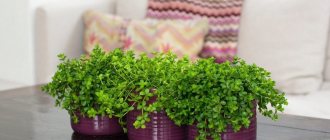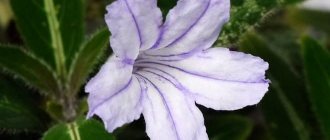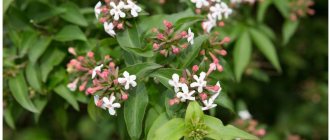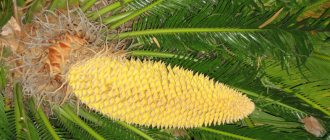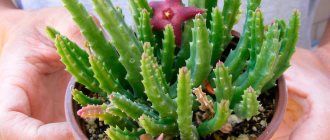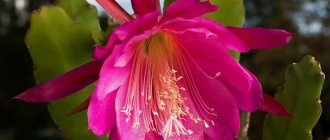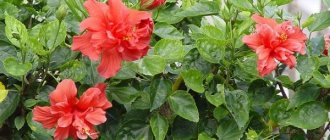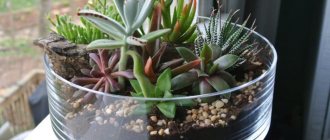According to the science of Feng Shui, indoor plants can influence us on an energetic level; they are ways of sucking out a person’s vitality and energy. Experts in the field of this science do not advise keeping flowers that are sick or withered in the house. Don't keep plants that don't sprout.
If, while caring for a flower, you notice that it cannot come to life in any way, this means that you will need to throw away the plant, as it has begun to spread negative energy.
If the plant was healthy all the time, and then, for no apparent reason, began to shed its leaves, then this means that your plant has taken on negative energy, thereby protecting your home.
The most harmful flowers according to the science of Feng Shui:
- Cacti. They are considered poisonous plants, according to the science of Feng Shui, since cacti are prickly, they contribute to quarrels and make people “thorny.” The sharp needles of a cactus can scare away a woman's betrothed.
- Monstera is considered an energy vampire, despite the fact that it has an attractive appearance.
- Yucca and sansevieria are considered “crybaby plants” and take energy from a person.
- Lilies are very beautiful indoor flowers, but you should not place them near where you sleep, they are energy vampires.
What folk items say about plants
When choosing a houseplant, you need to pay attention to how you feel; if you don’t like the flower, then you should not buy it and bring it home. You should buy those plants that will bring you positive emotions and, looking at which you will feel light and relaxed.
At the moment, there are a lot of folk signs regarding indoor plants:
- If a girl has a cactus in her house, then you should not count on a successful marriage. But only if the cactus is in the bedroom. Also, it is better for married women not to keep a cactus, since it is believed that a cactus in the house is the reason for the alcoholism of the man in the family.
- If you are given a palm tree, do not bring it into your home, otherwise it can bring great misfortune.
- Ivy can be dangerous for women. According to legends, ivy escapes from men's houses and does not allow anyone near its owner.
- Violet brings bad luck to young girls in love.
There are a lot of signs about flowers, some positive and some negative. For some, a flower can bring good luck, while for others it can be symbolized with grief. You shouldn’t believe in omens; you need to choose a flower according to your inner convictions. If you like the plant, then you should definitely buy it.
Poisonous indoor plants
Some indoor plants can pose a danger to human life and to small children, so before buying a plant, you should first read its description.
Some plants were brought to us in Russia from the tropics and are not accustomed to such an environment, so it will be a natural process for the plant to protect itself by releasing toxic substances.
The most poisonous plants that you should not keep at home:
- Dieffenbachia is a beautiful plant with large leaves, despite this it is very poisonous, as it contains a crystal of calcium oxalate and salin. The juice should never be consumed, otherwise your tongue may become swollen and, due to the high heart rate, you may experience anaphylactic shock. If the juice gets on human skin, it can cause severe burns.
- Aglaonema is a poisonous houseplant that contains the poison alkaloid aroin. You may feel irritation when you touch the plant. If ingested, it can cause vomiting or even damage to the central nervous system, so you should be careful with this plant.
- Adenium thick is a poisonous plant, the juice of which can cause intoxication if it enters the human body.
- Euphorbia - the juice of this flower can be very dangerous for humans and cause severe redness and burning of the skin. If the juice gets into the eyes, it can cause temporary loss of vision. If ingested, it may cause symptoms such as dizziness, vomiting and poor circulation.
- Scindapsus is a houseplant that, upon contact with humans, can cause skin dermatitis.
- Rhododendron Sims is very poisonous to humans and can cause convulsions if ingested.
- Hydrangea is a poisonous houseplant that causes sweating, intestinal pain and nausea.
- Clivia is a beautiful houseplant, but be careful when handling the leaves of the plant, it contains poison, which, if entering the human body, can cause diarrhea and vomiting, and sometimes even paralysis.
- Cycas contains a toxin that, if it comes into contact with your pet, can poison it and lead to the death of the pet. You should keep such a plant away from your pet, it is just as dangerous as Zamia.
- Gloriosa is a houseplant that can cause kidney disease and at the same time impair blood clotting. If you are poisoned by this plant, it first manifests itself in the form of diarrhea, nausea and vomiting.
When purchasing another flower, we do not even know about some of the harmful properties of indoor plants, and then suddenly we notice emerging health problems. If a small child or animals live in the house, then you need to pay special attention to the choice of indoor flowers and plants in order to protect their livelihoods. Some types of plants contain poison in their sap or release harmful substances into oxygen.
In addition to plants that are not recommended to be kept at home, some flowers have an adverse effect on the human body. In this case, you need to choose the right location for the future green resident, without placing it in the bedroom or, conversely, in the kitchen.
There are a huge number of disputes and disagreements about dangerous plants in the house. All the sayings are mixed with various signs that can ultimately confuse a novice gardener. In this article we will look at plants with which you need to be careful and be aware of the likely consequences for the body and for energy.
Watering and humidity
Proper watering is an important condition for the well-being of the cicada. It is best to water the plant when the soil in the pot is half dry. Watering should be moderate, and excess water in the pan should be avoided.
Cycas grows very deep inside the pot, so there is a risk of waterlogging the soil and causing root disease. The plant also does not tolerate prolonged drought. Contrary to popular belief, its thick trunk is not capable of accumulating moisture.
The sago palm needs high humidity. Regular spraying of the leaves will only benefit it. The plant also loves to “bathe” under a lukewarm shower. To do this, you need to cover the trunk and soil with a waterproof film and spill the plant with water from the shower.
A very important point - during watering and spraying, you must ensure that water does not get on the trunk of the cycas to avoid rotting of the root system.
Read about the healing properties of scented geranium so you can always have medicine on hand. Do you want to have hydrangea at home? We have already prepared an article where we will talk about the features of breeding this beauty at home: Large-leaved hydrangea (indoor): luxury of color and texture
List of poisonous plants
This group of plants includes those species that should not be kept at home, especially in the presence of animals or children, due to their extremely dangerous properties. A child, like a pet, can be poisoned by such flowers or get burns if handled carelessly.
If there are no children or animals in the house, then take precautions when caring for such plants. Be sure to use gloves when working with these colors and wash your tools thoroughly. Never trim these flowers with a knife meant for eating in your kitchen.
Consider this group of plants:
- Dieffenbachia. A popular indoor plant that attracts gardeners with its huge yellow-green leaves that form a fluffy crown. The flower is dangerous because of its juice, which is released when the leaves or stem are cut. If a pet or child decides to chew any part of this flower, the juice that enters the body will cause severe poisoning. In addition, Dieffenbachia juice causes burns and irritation to the skin.
- Oleander (Nerium oleander). Popular for its bright crimson flowers. Ingestion of oleander juice into the body causes blindness. The smell of a flowering plant contributes to dizziness and poor health.
- Euphorbia (Euphorbia). This plant is represented by a huge number of species and various forms, so it cannot be described unambiguously. Many representatives are similar in appearance to cacti and have spines, the injection of which is also dangerous for a living organism. Euphorbia contains white sap in its stem and leaves, which causes burns and irritation on the skin. If it enters the body it causes poisoning.
Basic information about the Cycas flower
The name of the flower has Greek roots and means “palm tree”. However, as we have already clarified, Cycas and palm trees have nothing in common. However, in gardening, this plant is called both the cycad and the sago palm (solely because of the external similarity). The plant is distinguished by wide, long leaves of a very exotic shape. In the wild, some species of cycads can reach from two to five meters in length. At home, plant height varies from thirty to eighty centimeters. Over the course of a year, the plant gains no more than three centimeters. This allows us to conclude about his longevity. In the wild, the cicada can exist for a whole century. The plant blooms at home very rarely. The main reason is the inability to create ideal conditions for its development. Therefore, you can watch the alluring flowering of Sagovnikov representatives only in the greenhouse.
Things to remember! Cycas grows very slowly. The plant grows no more than 3 centimeters per year. Therefore, the consequences of improper care of the sago palm will not be immediately visible. And it will be almost impossible to correct them later.
List of plants that need to be treated with caution
There are a number of indoor flowers that can harm the human body only if they are placed incorrectly in the house. In addition, some plant varieties cause allergies or minor illnesses. The list of these plants is as follows:
- Lily (Lilium). A flower loved by many with a tart aroma. It is because of this concentrated odor that they are not recommended to be kept in the bedroom, as they can cause insomnia. At night, lilies release a lot of carbon dioxide, so you can wake up in the morning with a headache and tired.
- Ficus (Ficus). A green lush plant with oblong leaves. Ficus is not very dangerous for humans, but is more capable than others of causing allergic reactions.
- Orchid (Orchidaceae). A beautiful plant characterized by unusual flowering of various shapes and colors. It is better to place such a flower near your workplace because it stimulates the nervous system. If you place an orchid in the bedroom, it will lead to sleep disturbances.
We have a whole section on our website dedicated to orchids. Look, maybe you will find a plant that suits you, they have beautiful flowers!
All flowers with a strong aroma should be placed in thoroughly ventilated areas. Then problems with poor health will not arise.
Folk signs: what is possible, what is not?
To trust folk signs or not is a personal matter for everyone. It is worth remembering that most often signs arise on the basis of many years of observations of ancestors. Let's consider what the appearance of some indoor plants in the house entails:
- Cacti are an unfavorable plant for the home. It is believed that the presence of a cactus in an apartment turns a husband into an alcoholic. There is a second sign that says that in a house where there is a cactus, a girl will not get married successfully or will not meet her chosen one at all. The cactus also has a bad effect on relationships between family members.
- Ferns take away vitality from a person, being an energy vampire. In a house with a fern, a person will feel constantly tired, inactive, and sleepy.
- Ivy and climbing plants, according to popular belief, scare away men. In a house where there are such plants, a man will constantly strive to go somewhere. In addition, ivy negatively affects the state of mind, depriving a person of optimism and balance. It is best to keep such plants outside the house. So, ivy will act as a protector.
- Dieffenbachia is dangerous for its poisonous properties, and also takes away the health of household members.
- Mother-in-law's tongue is a plant that has practically no stem, with elongated longitudinal leaves with a bright green color. It is believed that the presence of such a flower in the house leads to loneliness and the inability of a girl to get married. The plant negatively affects female power, so it is dangerous to keep it in the bedroom. The flower seems to “drive” men out of the house.
- Sansevieria is a curious plant that looks like the tail of a fish. For this reason, it is also nicknamed “pike tail”. The leaves of the flower, painted green, have such a bizarre shape. The plant blooms and has a pleasant aroma. But, according to signs, it negatively affects family and personal life. The presence of this flower in the house leads to loneliness.
- Palm trees often decorate the interiors of many rooms, but it is better not to place such a flower in your home. The palm tree contributes to grief in the family if it was given to you. Save this plant for office spaces or other places.
- Ficus can cause allergies, but in addition, it is believed that the flower negatively affects the presence of children in the house. If you want a child, then this plant is not worth purchasing. There has been controversy about ficus for a long time. There is a completely opposite opinion about this plant. It says that ficus solves problems of infertility and promotes family well-being.
When organizing a flower corner in your apartment or landscaping your home, choose the flowers that best suit you based on your lifestyle, the appearance of the flower and its properties.
Caring for cicada at home - seasonal table
The decorative flower should be planted in good permeable soil. Cycas requires moderate watering: the colder the room, the less often the flower is moistened. The water should immediately pass through the soil into the pan. After half an hour it is drained.
When moistening the plant, make sure that large drops of liquid do not fall on the leaves. A fine cloud should create air humidity around the flower (70-80%). In such conditions, the cicas feels comfortable.
When caring for cycads, you should wipe the leaves with a soft cloth. Cycas responds gratefully to spraying with warm water and any air humidification. In winter, watering is reduced. The plant is provided with a state of rest.
| Parameter | Spring | Summer | Autumn | Winter |
| Location | Accommodation on the north, east side. Shading if located on a south window. | Safe from drafts. | ||
| Lighting | Sufficient provision of bright light. | Scattered sunlight. | Needs additional lighting. | |
| Temperature | +22°C | +26°C | +15…+17°C | Cool (not lower than +15°C) |
| Humidity | 50-80%, moisturizing 1-2 times a day. | Spraying at least 2 times a day. | ||
| Watering | Abundant irrigation twice a week. | Moderate watering as the soil dries (every 10 days). | ||
| Soil heating | Not required. | If the plant’s condition worsens, warm the soil 3-5 degrees above room temperature. | ||
| Feeding | Fertilize every 10-14 days. Use a liquid complex fertilizer for palm trees. | Apply universal fertilizer for non-flowering plants once a month. Avoid the presence of calcium and magnesium salts in the fertilizer. | ||
Over the course of a year, the cycas grows 3 cm, forming one level of leaves. With a good relationship, a long-lived flower develops for decades.
Errors in care and their elimination
| Options | Causes | Elimination |
| Yellowing of leaves |
| Feeding, placing on the north, east side, avoiding direct sunlight. Moderate watering. |
| Loss of external decorative appearance | Lack of light | Placement on a sunny window, creating additional artificial lighting. |
| Lack of growth |
| Create a substrate that is optimally suitable for the development of cycas. Irrigate with warm, filtered water. |
Transplantation: pot, soil, step-by-step description, features
For good growth, cycas needs slightly acidic, nutritious soil. The art of composing a substrate is the key to the prosperity of any indoor flower. Natural materials are used in approximately equal quantities:
- sphagnum moss with leaf litter;
- pine bark of various fractions - pre-processed, boiled;
- pine nut shell – prevents soil acidification;
- thorn soil – light, nutritious;
- peat – rich in microelements that improve the composition of any soil;
- small fractions of brick chips;
- coarse river sand;
- birch charcoal crumbs.
The mixture is sterilized before use (for example: in a microwave - +200°C, in a water bath - +80°C). You can use ready-made soil for palm trees.
Cycas is a slow growing flower. It will spend at least 3 years in a light, well-drained substrate.
- Remove the cicada from the shipping pot. The condition for safe extraction is preliminary drying of the soil for two days.
- Remove old soil from the roots.
- Dry the tuber under an ultraviolet lamp for 2 hours.
- Choose a new pot made of harder plastic: the plant will live in it for several years. For additional aeration, make holes in the side walls.
- Use a prepared substrate; the usual drainage expanded clay is not needed. The volume of the new pot is slightly larger than the size of the previous one.
- Place a 3 cm layer of substrate on the bottom. Leave the tuber bulb on the surface of the substrate, without digging into the soil, cover it with earth.
- Water the soil well, filling the pot with water to the level of the base of the root ball. Allow excess moisture to drain. Further watering should be carried out as the soil dries to a depth of 3 cm. Use slightly warm reverse osmosis water or purified through a filter.
- Choose a suitable location for the plant. The best is the east window. The abundance of sunlight without the scorching midday rays has a beneficial effect on it.
It is advisable to carry out transplantation at an early age.
A young plant can be replanted by transfer when the root system begins to grow. Adult cicadas disturb in extreme cases. Replanting is permissible in cases where roots grow beyond the drainage system. You can place the flower in a plastic pot. As it grows, use a larger pot that matches the interior of the room.
Feng Shui
According to Feng Shui, it is important to pay attention not only to the type of flower, but also to the state in which it is. There are several basic rules for keeping flowers and plants in the house according to Feng Shui:
- You should not keep dried flowers in your apartment.
- All old plants that no longer bloom or produce new shoots should be thrown out.
- Sick flowers should not be kept in the house, as they will take away your health.
- A flower that you have been caring for for a long time, but all your actions are of no use and it fades, should also be removed from the house. The plant spreads negative energy.
- It is worth choosing those flowers whose leaves are directed upward. According to Feng Shui, such plants bring positive energy into the house. Plants with leaves that stretch downwards, on the contrary, ground it.
- It is better to choose flowers with rounded leaves.
- You should not place a large number of plants in the bedroom or next to the bed.
- According to Feng Shui, all plants are divided into female and male (Yin and Yang). Women's plants include begonia, violet, crassula, and cyclamen. Citrus fruits, dracaena, chlorophytum and others are considered male plants.
- For the most favorable energy field, it is necessary to keep Yin and Yang plants in the house.
Reproduction
Cycas propagates by seeds and vegetatively. Obtaining seeds of this plant indoors is a difficult task even for experienced gardeners.
Therefore, the vegetative method is the only chance to get another copy of the cicada into your collection.
With proper care, bulbous shoots . They should be separated, and the cut areas should be dried for 24 hours and treated with a fungicide.
the separated “baby” must be planted in a peat-sand mixture or perlite and, with moderate watering, wait 4 to 9 months for rooting.
What does science say about dangerous plants?
First of all, let's look at the scientific side of the issue. After all, when growing plants, we want them not only to decorate the room, but also to be useful, or at least not cause harm to household members.
Dwarf bougainvillea. You should work with it carefully - bougainvillea juice can cause skin rashes
It's no secret that indoor plants can cause serious harm to their owners. So, some of them are poisonous, others are allergens, and others even combine these two dangers. In addition, some types of plants can negatively affect your well-being. For example, you may experience headaches or fatigue due to the strong aroma of some flowers.
However, do not panic and throw out all the flowers from your windowsill. After all, about 50 indoor plants are on the list of poisonous plants. This is approximately 2% of their total number!
Indoor plants from the “black list” can cause poor health
Transfer
Cycas should be replanted once a year for 5 years from the beginning of its growth. After the fifth birthday, it is recommended to replant as roots emerge from the drainage hole. This happens approximately once every 5 years.
The plant should be replanted very carefully , without destroying the soil around the roots. A deep pot slightly larger than the previous one is ideal for replanting. A thick layer of drainage at the bottom of the pot is another condition for the well-being of the cicada.
For replanting, you can use soil for palm trees or prepare a soil mixture yourself from the following components:
- 2 parts of turf land;
- 1 part humus;
- 1 part sand;
- 1 part leaf soil;
- 1 part peat.
Plants dangerous to children
First of all, all mothers take care of their children. Therefore, first of all, let's talk about those indoor plants that can be harmful to babies. The danger increases due to their excessive mobility and curiosity. They strive to touch or taste the new inhabitants of the house. Therefore, the choice of plants in a house where there are children should be approached especially carefully.
Decorative ferns in living room design. Allergy sufferers should be careful with them
One of the types of ficus. If you want to saturate the room with oxygen day and night, then it is better to choose another plant for this
Keep children away from the seemingly innocent and beloved plant lily of the valley because it contains cardiac glycosides. They harm the cardiovascular system, nervous system, and gastrointestinal tract.
Innocent and delicate, lilies of the valley will not harm adults, but they should be kept out of reach of inquisitive young children
Oddly enough, such a seemingly useful plant as celandine was also included in the list of dangerous plants. This is because it contains milky juice. If it gets on the mucous membranes or even the skin of a child, it can cause redness and burns. Its negative impact does not end there. Celandine contains alkaloids. If they get into the gastrointestinal tract, the child may be poisoned.
Many people know about the dangers of celandine. This medicinal plant contains alkaloids and can burn the skin with its juice.
In addition, you should get rid of those plants that have brightly colored fruits. For example, aglaonema is especially dangerous. When it self-pollinates, small red berries may appear. Children may want to pick them and taste them. However, they are extremely poisonous and can cause serious harm to health.
Children need to be explained which plants are poisonous and why. In the future, this will only be useful to them, but now it can protect them from poisoning.
Pink anthuriums are also dangerous to humans in some ways.
Other plants that are absolutely contraindicated for a child’s room include the following:
Cute Aechmea houseplant
- monstera;
- dieffenbachia;
- alocasia;
- ficus.
- cacti;
All of them have negative energy, and some are even poisonous. Others, like ficuses, intensively absorb oxygen at night.
Advice! Considering that it is extremely important for a child to always receive a lot of oxygen for normal development, it is better to avoid ficus in the house.
A chic ficus in the interior of a country house, for reasons of sanitary standards, will be incomparably more appropriate
In addition to the danger for children, you should also think about whether indoor plants benefit them. So, you need to choose those colors that have positive energy, add oxygen to the room, and purify the air. This is very important for a child.
Pests and diseases
Even if the rules of agricultural technology are followed, the plant may become sick or be attacked by harmful insects. In this case, it is necessary to take timely measures to save the flower.
Control of diseases and insect pests - table
| Problem | Symptoms | Control measures and prevention |
| Shchitovka | Sticky coating and tubercles on leaves and petioles. The leaf blades become covered with light spots, dry out and die. |
|
| Mealybug | A white coating similar to lumps of cotton wool, located in the axils of the leaves. The normal development of the plant is delayed. |
|
| Spider mite | The leaves become covered with cobwebs, on which small dots can be seen, become lethargic, turn yellow and die. |
|
| Rot | The trunk has become soft, brown spots have appeared on it, and the roots are rotting. | If this happens, the plant will be difficult to revive:
|
| Sooty mushroom | Settles on plants affected by mealybug. The leaves become covered with a black, soot-like coating, then dies. |
|
Photo gallery: pests and diseases of cycas
Shchitovka
Mealybug
Spider mite
Rot
Sooty mushroom
Poisonous plants
Poisonous indoor plants are dangerous not only for children, but also for adults. Therefore, check your window sills for the following types of plants:
- Alocasia. All its parts are extremely poisonous.
The tropical plant Alocasia is poisonous to humans
- Azalea (see photo). Its leaves contain toxic substances - glycoside and andromedotoxin. Other parts of the plant are also poisonous. Swallowing them is deadly.
Plants are allergens
Sadly, a fairly large number of indoor plants, often found in many homes, are allergens when they bloom.
Allergens, in addition to many of the plants listed above, include pelargonium, fern, cyclamen, rhododendron (aka azalea) and others. What reaction do they cause in humans? For example, aglaonema juice can severely irritate the skin and mucous membranes.
Hanging gardens made from pots of pelargonium. This flower can trigger an allergic attack
Fern is a strong allergen
Cyclamen during flowering can cause allergies
Dieffenbachia can decorate any windowsill thanks to its exquisite large leaves. However, it can cause tissue swelling if it enters the oral cavity. Why is this beautiful plant poisonous? Dieffenbachia can cause poisoning in a child or pet if they swallow its leaves. In addition, you need to be careful when replanting it or cutting off its leaves. In this case, you may get burned by its juice. Philodendron poses the same danger.
Move Dieffenbachia higher if there are children and four-legged pets in the house
Croton and oleander are also strong allergens, and ficus is by no means an honorable third place after them.
The dangers of favorite and common plants
Of course, the greatest danger lies in wild or exotic plants, which hardly anyone would think of growing on their windowsill. At the same time, you need to be careful even with such familiar compact plants as begonia, orchid, geranium and hydrangea. What is their danger?
Hanging pots with orchids outdoors are harmless
Regal hydrangea is also on the list of plants that require caution
Rarely does a windowsill now go without beautifully blooming geraniums. After all, this beautiful plant is unpretentious and does not require special care. In addition, it has a fairly long flowering period. However, geranium can lead to headaches or even severe asthma.
Geranium. One of the most common house plants
Other common houseplants are also dangerous. Recently, growing orchids at home has become fashionable. However, they have a relatively strong, pungent odor, which can lead to insomnia or simply worsen your mood, which is also unpleasant.
A plant so beloved by many gardeners as azalea is also fraught with danger. If its leaves enter the body, it can cause convulsions and intestinal colic.
Everyone's favorite begonia is also fraught with some danger. This seemingly harmless plant has the property of releasing volatile substances. They fight pathogenic microbes. Of course, this is a positive property of the plant. However, you need to work with it carefully. This is because begonia contains insoluble salts of oxalic acid. They can cause severe burns and mouth irritation.
Gardeners' favorite begonia
White begonia inimitably decorates any interior. It also has antimicrobial properties due to phytoncides. This is her plus
You should also treat such beautiful flowers as lilies with caution. At night, they intensively absorb oxygen and release carbon dioxide. So don't be surprised if you wake up with a headache the next morning.
Advice! It is not recommended to keep lilies in the bedroom.
It is not advisable to place lilies in the bedroom
Types of cycas for indoor breeding
In areas with a mild, warm climate, the sago palm is used for landscaping streets and squares.
In indoor floriculture, a small number of varieties are used for breeding.
| View | Description |
| Revoluta | The most common variety. The columnar trunk reaches a height of 3 m. Topped with a lush crown. The length of the odd-pinnate dark green leaves is 2 m. |
| Siamese | The height of the thickened trunk is 1.6-1.9 m. The length of pointed leaves is 10 cm. The stalk is covered with thorns. The color of the leaves is bluish-white. |
| Curled | On a columnar trunk 2 m high, leaves are formed in a bunch of 15 pieces. The rachis is covered with spines from the crown to the middle. The trunk of an adult plant has lateral shoots; they are used for rooting. |
| Rumpha | The highest grade. The feathery leaves reach a length of 2 m. |
| Comb-shaped | Small tree. Dying leaves hang down the trunk. The name of the plant is due to its resemblance to the cockscomb. |
Folk signs
There are many legends about which flowers should not be kept at home. Since the majority of avid flower growers are women, most of the folk wisdom boils down to the fact that due to the wrong choice of plant, a husband can leave, cheat, become an alcoholic, die, etc. Who among us has not heard “horror stories” about ivy? Which under no circumstances should be kept at home, otherwise there is a high probability that your spouse will leave you. This mainly applies to climbing ivy (see photo). Wax, its relative, is contraindicated for an unmarried girl. If she dares to grow it, then there is a high probability of remaining an old maid.
There are many legends and beliefs about ivy
Despite popular beliefs, ivy purifies the air, reducing the content of microbes in it
Thus, if you believe the signs, then ivy and marriage are completely incompatible things. And these beliefs arose, most likely, because ivy is considered an energy vampire.
If you can still believe in some signs, then there are completely strange beliefs. For example, there is a legend among the people that if you are given a palm tree, it is strictly forbidden to bring it into the house, as this can lead to misfortune. However, with such a gift you can find a way out of the situation. You can simply roll the palm tree into the house on a bicycle.
Beautiful palm tree in a modern interior. There are strange and curious beliefs about her
